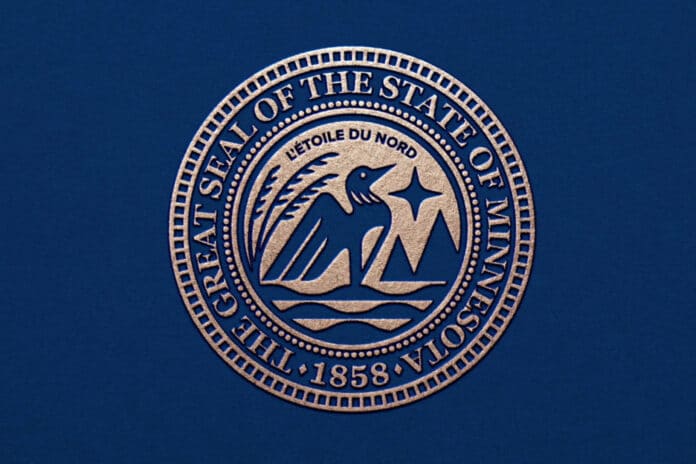A task force appointed this summer by the legislature and Gov. Tim Walz is nearing its Jan. 1 deadline to approve a new state seal and flag design.
On Tuesday afternoon (and possibly into the evening) the State Emblems Redesign Commission is expected “to discuss modifications to the chosen state seal” design it approved last week, according to a press statement from its communications staff. The meeting will be held at the State Senate Building across from the Capitol building.
UPDATE: The State Emblems Redesign Commission has just voted 8-2 to strip the statehood year “1858” from the new state seal design it approved last week. Secretary of State Steve Simon was one of the two votes against the motion to remove the year "1858" from the seal. https://t.co/9YuhqyxokT
— Alpha News (@AlphaNewsMN) December 12, 2023
One element of the design — the statehood date of 1858 — may or may not be eliminated, based on conversations commission members have had in recent weeks during their weekly meetings. It’s also expected to select a final flag design submission from among six finalists it chose last month.
NEW: After stripping the statehood date and state motto from the new state seal, the State Emblems Redesign Commission also voted to add the Dakota term "Mnísota Makoc̣e" to the seal. This is despite clear legal directions that say: “Symbols, emblems, or likenesses that represent… pic.twitter.com/nfEfIxTegG
— Alpha News (@AlphaNewsMN) December 12, 2023
On Tuesday, Dec. 5., the commission chose its favorite state seal submission design from among five finalists that features a scene where a loon appears to be taking flight from the surface of a body of water. Included in the background of the design that the 13-member body unanimously agreed on are a few grains of wheat, a north star, and what appears to be coniferous forest in the distance.
The design is bordered by the year “1858,” which memorializes Minnesota’s statehood date, the phrase “The Great Seal of the State of Minnesota,” and the official state motto “L’etoile du Nord.”
Two of those elements have been criticized by two members of the commission as “hurtful” to indigenous people. And their concerns have been supported by at least one of the legislators on the commission.
During a November meeting in which the commission was discussing elements they liked and didn’t like among a number of state seal design submissions they were considering, commissioner member Kate Beane said she objected to incorporation of the statehood date on the seal or the flag.
“ … The seals that included 1858, I had a very hard time picking any seal that included that year, for statehood, because for us as Dakota people, 1858 is tied to land cession treaties,” Beane said during a lengthy meeting the commission held on Nov. 21 as it began a process of narrowing design submissions it liked from a pool of more than 2,000 entries.
“And it’s a hurtful, hurtful date, and a difficult time in history,” Beane continued. “And I think we, you know there are different, if we are truly going to be talking about symbolism that is inclusive, we need to really think about how the symbolism of that date impacts other people in Minnesota as well.”
Beane, an executive director for the Museum of Minnesota Art, was appointed to the commission as a representative of the Capitol Area Architectural and Planning Board. She was one of the founding organizers of a movement that began nearly a decade ago to rename Lake Calhoun in Minneapolis.
Beane also expressed concern over the use of French language state motto “L’etoile du Nord” on the state seal. Both the year 1858 and “L’etoile du Nord” are included in the existing state seal that is set to be retired, via statute on May 11, 2024, as long as a new seal is selected by the Jan. 1 deadline.
“ … Choosing which languages we use (on the seal) I think is really important to be inclusive of people throughout the state, and I understand that’s written into statute,” Beane said. “I also was wondering is language, and should words be a part of the seal then? And if so, how do we spell them? Do we use the Dakota spelling of Minnesota? How do we reflect that in a way that is more inclusive?”
Beane’s concerns were echoed by fellow commission member Shelley Buck.
“I agree with Dr. Beane,” said Buck, a Walz appointee to the commission. “It was really hard (for me) with the seals. Even with the French, I believe it is a French word, or words, I don’t feel that’s really who Minnesota is.”
Bill author says state motto could be left off if deemed ‘problematic’
Secretary of State Steve Simon, also a member of the commission, chimed in during that Nov. 21 discussion and said the body isn’t bound by statute to include the official state motto in French.
“Hypothetically, we could put ‘Star of the North’ on there, and someone could say well by statute, that isn’t the state motto, but it is what we put on there.”
Rep. Mike Freiberg, DFL-Golden Valley, who sponsored the bill to replace the existing state seal and flag with a new one, also expressed support for the idea of the commission deciding to not include the “L’etoile du Nord” motto on the final rendering of a new state seal design.
“I don’t think there is a requirement that we include the motto on the seal necessarily at all,” Freiberg said. “It could be in a language beside French, but it could just also not be there.”
“I am looking at the one design that got the most votes, it does have the motto, it does have the year on it,” Freiberg continued. “But as Secretary Simon said, we do have the ability to vary from these designs, so we could just choose to leave off the motto if the majority of the commission feels that is problematic.”
“Having a pictorial representation of the motto (in the North Star) without the words in any language would be a logical way to go.”
Hank Long
Hank Long is a journalism and communications professional whose writing career includes coverage of the Minnesota legislature, city and county governments and the commercial real estate industry. Hank received his undergraduate degree at the University of Minnesota, where he studied journalism, and his law degree at the University of St. Thomas. The Minnesota native lives in the Twin Cities with his wife and four children. His dream is to be around when the Vikings win the Super Bowl.

















